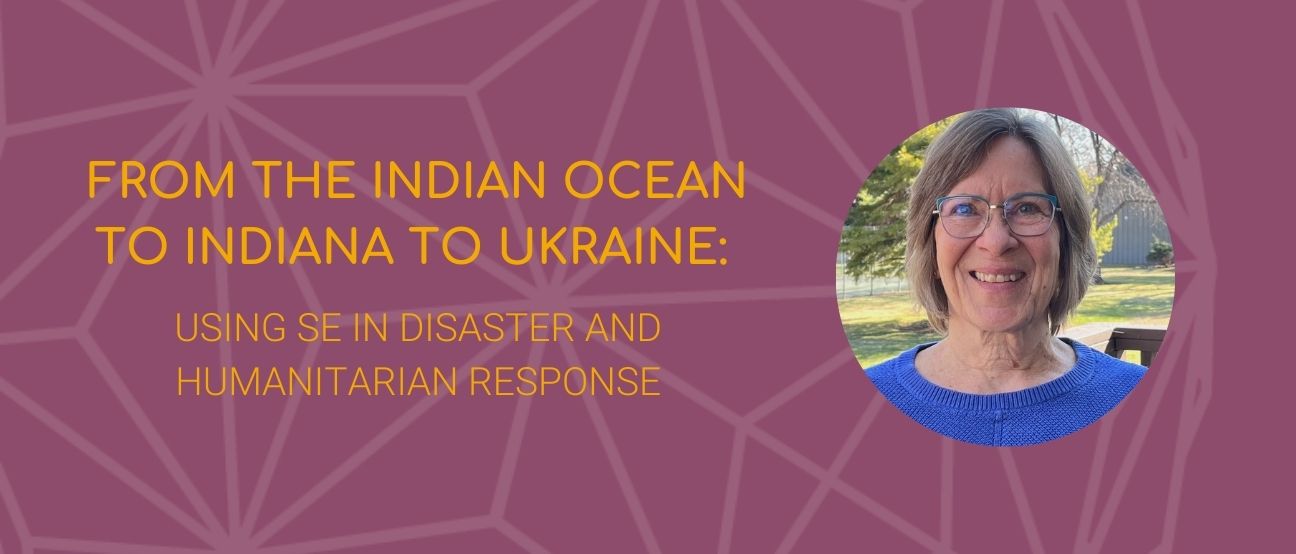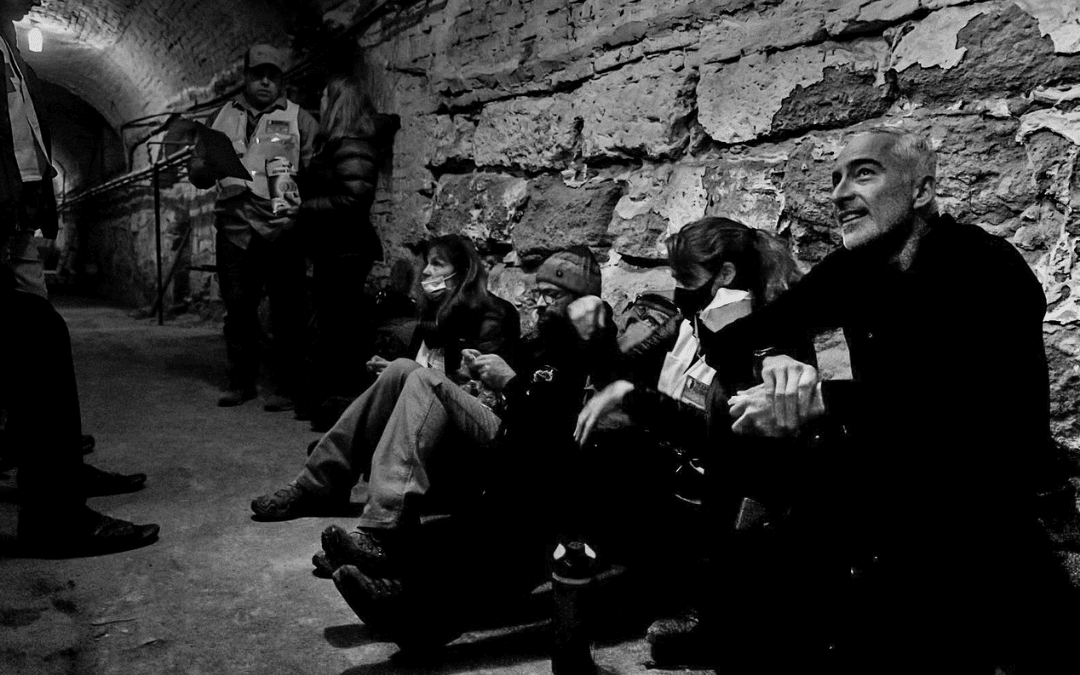
“Along the way I developed a spiritual world view that allowed me to accept suffering as a part of life. It’s how we respond to it that’s so important.”
In September 2021, refugees from Afghanistan began arriving in Indiana, a state that calls itself “the crossroads of America.” Eventually, 7,200 would come, beginning the process of a new life in America. They started at Camp Atterbury, an Indiana National Guard base designated as one of eight nationwide “safe haven” sites for Afghan refugees. In the early days of arrivals, from 80 to 200 evacuees arrived every hour, getting medical screenings and a stack of paperwork to complete. The refugees lived in 68 single-story barracks spread throughout the camp’s 36,000 acres. Lisa LaDue, LCSW, SEP, was there to help them, serving as the behavioral health team lead, supervising a team of 11 licensed clinical social workers and licensed professional counselors providing culturally appropriate behavioral health services. The team’s work included trauma co-regulation, mindfulness, and somatic-based stabilization and skills training.
“Despite what I saw in my previous work, especially at the Pentagon after 9/11 and the 2004 tsunami in the Indian Ocean, this was the worst loss I’ve witnessed and shared,” says Lisa. “The refugees from Afghanistan lost everything – their homes, their country, their identities, their family members in many cases. Some of them even lost the luggage they left with. They were totally displaced halfway around the world.”
Many were single men who had worked with the U.S. military and were told to get to the airport and leave immediately, without their families. Some received pictures of family members killed by the Taliban – “to make sure these men knew what had happened.” Others received desperate messages from their wives and children saying they had no food and no way to get it. “The most important thing we did was just sit with them and listen to their stories. They needed to know that they were seen and heard by another human being who cared.”
At first, addressing basic needs was haphazard – and improvised. Lisa traced children’s feet and took the tracings to the warehouse of donated goods looking for shoes that would fit. Ongoing needs had to be addressed by understanding cultural differences – men often spoke for the women or were physically in front of them (“We had to remember that they came from an environment where the men literally shield their families from harm by stepping in front of them”) and in culturally sensitive ways. “Just because we SE practitioners are trained to use touch doesn’t mean that’s welcome by all,” says Lisa. “We were very careful to ask permission and to train other staff to be careful about even casual touch, such as touching someone’s arm. In many cases, I was considered an ‘elder,’ which made the touch permissible to the men. Women, on the other hand, wanted hugs and to cry in our arms.”

On to Ukraine: Bomb Shelters and Hugs
By the end of January, five months after Lisa arrived, all the Afghan refugees had been resettled, including 450 who made Indiana their home. In early March, Lisa was on to her next stop in 30 years of disaster and humanitarian work – in Ukraine. As a member of Team Rubicon’s International Team, Lisa provided mental health services for the team and Ukrainian refugees and internally displaced people (IDP), first in Poland and then in and around Lviv, Ukraine. It was like no other experience in her disaster response experiences. During the team’s 3-week deployment to provide medical and mental health care for Ukrainians affected by the war, the team provided care for people at temporary and more permanent shelters. Their days and nights were filled with intermittent air raid sirens, sending everyone to bomb shelters and creating constant underlying physical and mental fatigue.
Olga, a 70-year-old Ukrainian widow, cried as she talked about being alone, recovering from cancer, and now leaving her home because of heavy shelling in her hometown. When asked about a resource, Olga told Lisa she loved her plants, especially her favorite flowers, dahlias. She and Lisa agreed that they would each think of the other whenever they see a beautiful dahlia from then on. Her blood pressure, high enough to concern the team’s doctors, dropped more than 20 points after her talk (and hugs) with Lisa. The medical team soon openly embraced the use of somatic techniques with patients suffering from anxiety, fear, and the lack of a sense of safety.
Lisa started her career as a licensed clinical social worker after getting her bachelor’s and master’s degree in social work from the University of Iowa and working at several hospitals (she has been licensed as an LCSW in four states). Eventually, Lisa moved from Iowa to California, working as an LCSW in two hospitals and two tribal health clinics that served Native Americans, providing mental health and substance abuse services. While working at one hospital in California, she realized that her favorite place to be in a hospital was in the Emergency Room. “It surprised me to acknowledge this, because I was a very phobic child – I was scared of everything, especially ambulances that went by. I also had a huge phobia about dying and one of my first assignments as a hospital social worker was in oncology. I finally concluded that the universe was always putting me exactly where I needed to be, regardless of my wishes.”
The hospital set up a disaster response committee for the ER and Lisa became intrigued. When the Oklahoma City bombing happened, “I desperately wished to be there. Shortly after, I moved back to Iowa, completed a disaster mental health volunteer class with the Red Cross, and two weeks later I was in Puerto Rico for my first disaster response assignment, supporting Red Cross volunteers after Hurricane Hortense. I knew from the minute I arrived that this was what I’d been preparing for all along.”
Then came 9/11. Because of her previous roles with the Red Cross, Lisa was certain she’d get a call. “In fact, when I saw the plane hit the second tower, I started doing laundry and packing. I don’t like big cities, but there wasn’t a question of whether I’d go or not.”
She was assigned to brief and debrief disaster mental health volunteers going directly to the Pentagon, assisted with the employee assistance program for the Department of Defense (DOD) at the Pentagon, and created a critical incident stress team to respond to requests from the community. Finally, she was assigned to work at the Pentagon Family Assistance Center, supervising the disaster mental health services in coordination with the DOD. After a month in Washington and a month back home, Lisa spent two weeks in New York, supervising the disaster mental health services on Long Island.
Within a few months after these deployments, Lisa realized she was likely suffering from post-traumatic stress herself. A picture of the Pentagon brought back the smell of the burned structure and brought on immediate tears. She couldn’t sleep, she experienced tunnel vision in crowds, she thought her career might be over. “I didn’t understand what was happening and thought that all my cognitive therapy training was worth nothing and that it meant nothing for all the people I’d tried to help, people who needed something for trauma. Because of my failure to manage my own post-trauma symptoms, I knew I had to find something that would help. I went to a conference in San Diego and heard Peter Levine talk about Somatic Experiencing and said to myself, ‘That stuff – that’s it, that’s what I need.’”
Lisa started her SE training almost immediately after and completed it in 2005. When the Indian Ocean earthquake and tsunami hit, she went with a small team of SE-trained therapists in response to a call from Peter Levine’s brother-in-law, who was a psychologist in Thailand. A primary focus was working with children who had been orphaned by the tsunami and training teachers how to help children. Maggie Kline, SEP, a SEI faculty member, and Ale’ Duarte, SEP, led the counselors in play that helped the children release incomplete survival responses and regulate their systems. “There was just an ocean, pardon the pun, of need,” says Lisa. “Like at the Pentagon, the fear and the grief were palpable, and very heavy.”
Suffering as a Part of Life
Lisa has now developed disaster training programs or worked in disaster response using SE in Ukraine, Germany, Austria, Nepal (multiple times), Guam, Thailand, India, and China, and in the U.S. in Puerto Rico (multiple times), California, Oregon, Iowa, Louisiana, Mississippi, and Indiana. As the director of the National Mass Fatalities Institute, developed with a colleague in Iowa in 2000, Lisa is considered a subject matter expert in mass fatalities management and has provided training for more than 20 jurisdictions around the country and in Nepal.
For eight years, as part of her life of relative solitude in the mountains, Lisa served as a volunteer firefighter for Glacier View Fire Protection District in Livermore, Colorado. “I thought I was pretty well prepared to be a first responder since I had so much disaster response experience. But there is nothing like being a first responder to structure fires, wildland fires, crumbled vehicles and people experiencing medical emergencies. I learned and grew a lot, often being challenged to use SE and all I know about trauma to regain my own balance and stability.” During this period, she created Lion Path International, developing trauma intervention training programs. She has a private psychotherapy practice in Fort Collins focused on somatic interventions, has lectured in the graduate school of professional psychology at the University of Denver, was on the faculty of the Colorado State University School of Social Work, and has written articles, curricula, or book chapters on disaster response, mass fatalities, pandemics, mental health during national tragedies, and bioterrorism response.
Lisa has a simple message for other SEPs, students, assistants, or others involved in mental health when the question to her is, “I’d like to be involved in disaster and humanitarian response, but where do I start?”
The first place to start, says Lisa, is locally – “There are always needs, such as food banks, shelters, and local disasters. If you’re willing to invest some time, you’ll find plenty of places to help. Eventually you might find yourself in a state far away or even another country. And, most importantly, you may find that this kind of volunteer work is not for you. And that’s okay. Disaster response and humanitarian work requires significant sacrifice, a commitment to self-care, and a monitoring of your own motives and agendas. For myself, along the way I developed a spiritual world view that allowed me to accept suffering as a part of life. It’s how we respond to it that’s so important. Using SE has helped me assist others without causing more harm and has given me the tools to process and release the trauma to which I’m exposed. SE definitely saved my career, and it may have saved my life – I believe making it the foundation for my practice has saved others, too.”
More information on Team Rubicon, a veteran-founded disaster response organization: https://teamrubiconusa.org/story/
